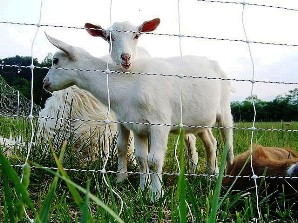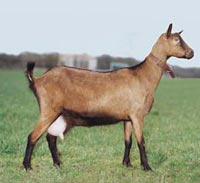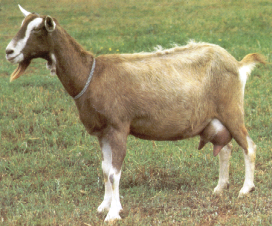Which breed of dairy goats should I keep?
Although there are many breeds of dairy goats in Kenya, only three are the most common and therefore important. Your choice of dairy goat breed will by and large depend on your locality because each breed is suited to certain climatic conditions. The three important breeds are Saanen, Alpines and Toggenburg.
Saanen
White to pale cream in color, they have black spots on the nose and udders and the skin is black spotted. They are usually polled, meaning they are not horned. The ears are normally pointed facing forward.

Mature male weigh about 75 Kg and females 50 – 65 Kg. The breed is used to upgrade local goats.
The highest recorded milk yield in the tropics is 800 Kg in 205 days lactation or 3.9 Kg/day. The current world record 3430 Kg per lactation in temperate regions. Butter Fat (BF) content is around 4%.
Problems associated with Saanen are:
- Sensitive to strong sunlight therefore skin cancer
- Sensitive to high temperatures
- Hermaphrodites are very common
Alpines
These breed of dairy goat adapt in the tropics better than the Saanen. German Alpines are more widespread and the color is variable but can be grouped i.e.
- White front quarter and black hind
- Grayish front and black hind
- Black neck and white hind

Female weigh 60 Kg and male 65 Kg at maturity. Milk yield averages 922.5 Kg per lactation or 4.5 Kg per day and BF content is at 3.6%. The current milk record 2194 kg/lactation.
Toggenburg
This is the least successful exotic breeds in the tropics. Togs have white legs, white stripe from nose to eyes and a characteristic white triangle at the back.

Mature males weigh 65Kg and females 45 Kg.
Milk production is about 3 liters/day and the world record 2613 kg/lactation or 12.5 kg/day. They can produce milk for a long time if not served and are good for upgrading local breeds.
These three breeds are adaptable to a wide range of climate. Alpines and Saanen are hardy and can do well in hot areas. Toggenburg do well in cold areas.
Other than the breeds, the other very important factor is how well you are prepared in terms of management. These goats are high producers and demand a high management level in terms of feeding, husbandry, housing and health.



Comments
this site and be up to date every day.
I like what I see so now i'm following you. Look forward
to going over your web page for a second time.
but your sites really nice, keep it up! I'll go ahead and bookmark
your website to come back down the road. Cheers
1.Fodder
2. Medicine
3.Labour
4. Maintenance + water intake.
Visa vis amount of milk you get from a grade hi cow.
My calculations do not add up.
Better a milk goat than a cow.
I am thus looking to have a reliable and well trained qualified vet in Kajiado to possibly discuss professional arrangement of attending to my herd. I appreciate being given contacts.
RSS feed for comments to this post